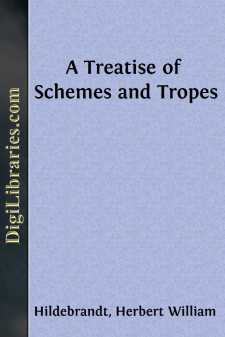Categories
- Antiques & Collectibles 13
- Architecture 36
- Art 48
- Bibles 22
- Biography & Autobiography 813
- Body, Mind & Spirit 142
- Business & Economics 28
- Children's Books 15
- Children's Fiction 12
- Computers 4
- Cooking 94
- Crafts & Hobbies 4
- Drama 346
- Education 46
- Family & Relationships 57
- Fiction 11828
- Games 19
- Gardening 17
- Health & Fitness 34
- History 1377
- House & Home 1
- Humor 147
- Juvenile Fiction 1873
- Juvenile Nonfiction 202
- Language Arts & Disciplines 88
- Law 16
- Literary Collections 686
- Literary Criticism 179
- Mathematics 13
- Medical 41
- Music 40
- Nature 179
- Non-Classifiable 1768
- Performing Arts 7
- Periodicals 1453
- Philosophy 64
- Photography 2
- Poetry 896
- Political Science 203
- Psychology 42
- Reference 154
- Religion 513
- Science 126
- Self-Help 84
- Social Science 81
- Sports & Recreation 34
- Study Aids 3
- Technology & Engineering 59
- Transportation 23
- Travel 463
- True Crime 29
A Treatise of Schemes and Tropes
Categories:
Description:
Excerpt
INTRODUCTION
Richard Sherry’s A Treatise of Schemes and Tropes (1550), a familiar work of the Renaissance, is primarily thought of as a sixteenth-century English textbook on the figures. Yet it is also a mirror of one variation of rhetoric which came to be called the rhetoric of style. As a representative of this stylistic school, it offers little that is new to the third part of classical rhetoric. Instead, it carries forward the medieval concept that ornateness in communication is desirable; it suggests that figures are tools for achieving this ornateness; it supplies examples of ornateness to be imitated in writing and speaking; it supports knowing the figures in order to understand both secular and religious writings; it proposes that clarity is found in the figures. In short, the work assisted Englishmen to understand eloquence as well as to create it.
Four-fifths of ancient rhetoric is omitted in the Treatise. The nod is given to elocution. Invention is discussed, but only as a tool to assist the communicator in amplifying his ideas, as a means to spin out his thoughts to extreme lengths. Arrangement, memory, and delivery are overlooked. Accordingly, the Treatise neatly fits into the category of a Renaissance rhetoric on style. It is this school which recognized the traditional five Ciceronian parts of rhetoric, but considered style to be the most significant precept. The Treatise is not the first to support an emphasis wholly on style, nor the foremost. We know that Aristotle’s Rhetoric, Cicero’s works on rhetoric, and Quintilian’s Institutes discussed the significance of style, but they had a broad view. However, in England, about the time of Bede, arose a limited concept that rhetoric is mainly style, particularly that of the figures. It is this latter truncated version of rhetoric that the Treatise continues in the Renaissance. Rhetoric in Sherry’s work has lost its ancient meaning.
The Treatise is highly prescriptive. It was born in an age of rules. So much so, that the rhetorician who named his rules and tools was not out of rapport with the period. This accounts for the rigidity, the love of classification, and the schematic presentation of the work. It is nothing more than a highly organized dictionary of ancient, medieval, and Renaissance schemes and tropes. In fact, the major variation from previous Latin compilers is to be found in the headnotes relative to the various kinds of figures. Nor is it as thorough in handling the figures as its predecessors. It utilizes, however, the customary Greek and Latin terms and supplies a definition, but here the similarity with contemporaries and ancients ends. It is weak in amplification of examples during an age when amplification was practiced. Sherry economizes by selecting usually one example in support of a figure while contemporary cataloguers, and ancients for that matter, are more definitive.
Whether the work was ever popular within the schools or without is unclear. Probably it did not have extensive success because only one issue of the work appeared and a revised edition was brought out in 1555....


